THIS is my NEW FAVORITE PAN (and that’s before I have even used it, LOL!)
SolidTeknics, Made in USA, frying pan (2018)
For those new to the Lead Safe Mama website:
Tamara Rubin is a multiple-federal-award-winning independent advocate for childhood Lead poisoning prevention and consumer goods safety, and a documentary filmmaker. She is also a mother of Lead-poisoned children (two of her four sons were acutely Lead-poisoned in 2005).
- Tamara owns and runs Lead Safe Mama, LLC — a unique community collaborative woman-owned small business for childhood Lead poisoning prevention and consumer goods safety.
- Since 2009, Tamara has been conducting XRF testing (a scientific testing method) using the exact instrumentation employed by the U.S. Consumer Product Safety Commission to test consumer goods for toxicants (specifically heavy metals — including Lead, Cadmium, Mercury, Antimony, and Arsenic).
- Since July of 2022, the work of Lead Safe Mama, LLC has been responsible for 5 product recalls (FDA and CPSC).
- All test results reported on this website are science-based, accurate, and replicable.
- Items that Lead Safe Mama, LLC reports on are tested multiple times to confirm the results published (for each component tested).
- Recent notable press… There has been too much to mention already in 2024! Please check out our press page to see some of the amazing coverage of our work so far this year!
A friend in Australia had this shipped to me to test. I am going to start this piece off by sharing the XRF results, then I will include a list of all the reasons I think this pan is a wonderful “safer choice” (from both a non-toxic and design perspective — plus other reasons, too)! Please read the post in full, scrolling past each of the images.
NOTE: I do not — yet — have an affiliate link for this company or this product.
When tested with an XRF instrument, the pan pictured had the following readings:
(XRF materials type noted: “Metal-430/40” when tested in “Consumer Goods” mode)
Test one:
(180 seconds/3 minutes)
- Lead (Pb): Non-Detect / Negative
- Cadmium (Cd): Non-Detect / Negative
- Arsenic (As): Non-Detect / Negative
- Mercury (Hg): Non-Detect / Negative
- Barium (Ba): Non-Detect / Negative
- Chromium (Cr): 137,300 +/- 600 ppm
- Antimony (Sb): Non-Detect / Negative
- Selenium (Se): Non-Detect / Negative
- Tin (Sn): 108 +/- 31 ppm
- Copper (Cu): 1,631 +/- 167 ppm
- Nickel (Ni): 2,056 +/- 240
- Iron (Fe): 851,600 +/- 1,200 ppm
- Vanadium (V): 598 +/- 101 ppm
- Magnesium (Mn): 4,698 +/- 664 ppm
Please continue reading after the image.
Test two:
(60 seconds)
- Chromium (Cr): 159,700 +/- 1,900 ppm
- Tin (Sn): 109 +/- 37 ppm
- Copper (Cu): 1,282 +/- 187 ppm
- Nickel (Ni): 1,822 +/- 281
- Iron (Fe): 830,600 +/- 2,300 ppm
- Magnesium (Mn): 4,691 +/- 788 ppm
- Metals not listed here were not detected.
Multiple XRF tests were completed in different spots, and all were in similar ranges as the above two sets of test results (although some readings registered as “Non-Detect” for Tin and Vanadium).
Please continue reading after the images.
Here’s what I like about this pan:
- There are NO grommets (no attachment points for the handle). Many stainless pans have grommets attaching the handle and those grommets are usually made of a different metal than the pan — and (in my experience, after testing hundreds of different pans) often result as positive for Lead when tested with an XRF instrument.
- Bucking the “fashion trend,” there is no toxic coating nor decorative elements (made of additional materials) on the pan (non-stick, enamel, brass, or otherwise).
- The pan (including the handle) is made of one solid contiguous piece of metal, so there is no concern of eventual possible de-lamination/ separation of dissimilar metals due to overheating, corrosion, etc. Many other pan brands have handles made out of a combination of materials (even when the pan is advertised as “solid stainless steel”). Those other materials used for handles often contain Leaded components. (Especially trendy right now are Leaded-brass accent handles, LINKED here.)
- The type of metal used for this particular pan (ferritic stainless steel*) is very low-Nickel, similar to many of the stainless pans from Ikea. While I don’t personally have a concern for Nickel in my stainless pans, some people do, especially if they have been diagnosed as having an allergy/ sensitivity to Nickel.
- The design is adorable! I love the little map of the United States in the handle. 🙂 I also love the balance and weight of the pan.
- The pan has a “multi-century” warranty! This is amazing (and fun)!
- The pan does not need seasoning.
- The pan is Made in the USA (by a division of a company that was originally started in Australia).
- The pan is stamped with the month and year of manufacture for batch traceability (I think this is incredibly responsible of the company to have the foresight to do!).
Please continue reading below to see the one (single) concern I have about the product…
I have just one concern about the pan, and that is the language used to describe the type of stainless steel used. Please read the following:
*Without getting too technical, there are a LOT of different stainless steel alloys out there, grouped into four basic categories: “Austenitic”, “Ferritic”, “Martensitic”, and “Duplex” (with many different alloys within each of these basic groups — each one defined by the specific alloying elements, and the percentages of each one present in the particular “recipe”). In the event that this subject interests you, you can read more about that HERE.
In the case of these pans, the alloy used is a ferritic stainless steel (430/40).
The lay-language being used to describe this specific material is “non-Nickel” stainless steel, however it is important to note that a “non-Nickel” stainless alloy is not necessarily literally “Nickel-free”.
What this language is meant to convey is that the stainless sub-type used for this pan is not a Nickel-based stainless alloy. Said another way: Nickel is not a primary nor significant component of the alloy.
MOST stainless cookware items I have tested are made of one of the more common high-Nickel-content/”Nickel-based” alloys (most commonly, 304 stainless) – which typically contains between 82,000 and 90,000 parts per million (ppm) Nickel. [LINK] By contrast, this particular pan that was sent to me is approximately 2,000 ppm Nickel. this means it is just about 0.2% Nickel or less, and thus legitimately falls within the category commonly referred to as a “non-Nickel” stainless.
My concern is that consumers (especially American consumers) will likely easily be confused — believing/thinking that “non-Nickel” stainless means “Nickel-free“, and this is not always the case (as with this particular pan from this company pictured here – which was made in September of 2018.)
This concern is compounded by the name of the company / product-line: “nöni”, which I am assuming stands for “Non-Nickel” (referring to the non-Nickel-based stainless alloy)!
All that said, I think this is still a terrific choice for a pan!
Additional images of the pan and packaging are below. Here’s a link where you can buy this pan (this is not an affiliate link and I am getting no commission for making this referral at this time): LINK.
Note to the manufacturers (if they read this piece): If you are truly wanting these pans to be Nickel-free, please look into the metal alloys used by Ikea for their pots and pans (many of which are fully Nickel-free) — and you may also want to consider conducting XRF testing (by batch) in advance of manufacturing each batch (just to confirm the levels of the various component metals in the stainless). Truly Nickel-free stainless alloys are available.
As always, please let me know if you have any questions.
Thank you for reading and sharing our work.
Tamara Rubin
#LeadSafeMama
Here are the features of these pans as listed on a website that is selling them:
Never Miss an Important Article Again!
Join our Email List









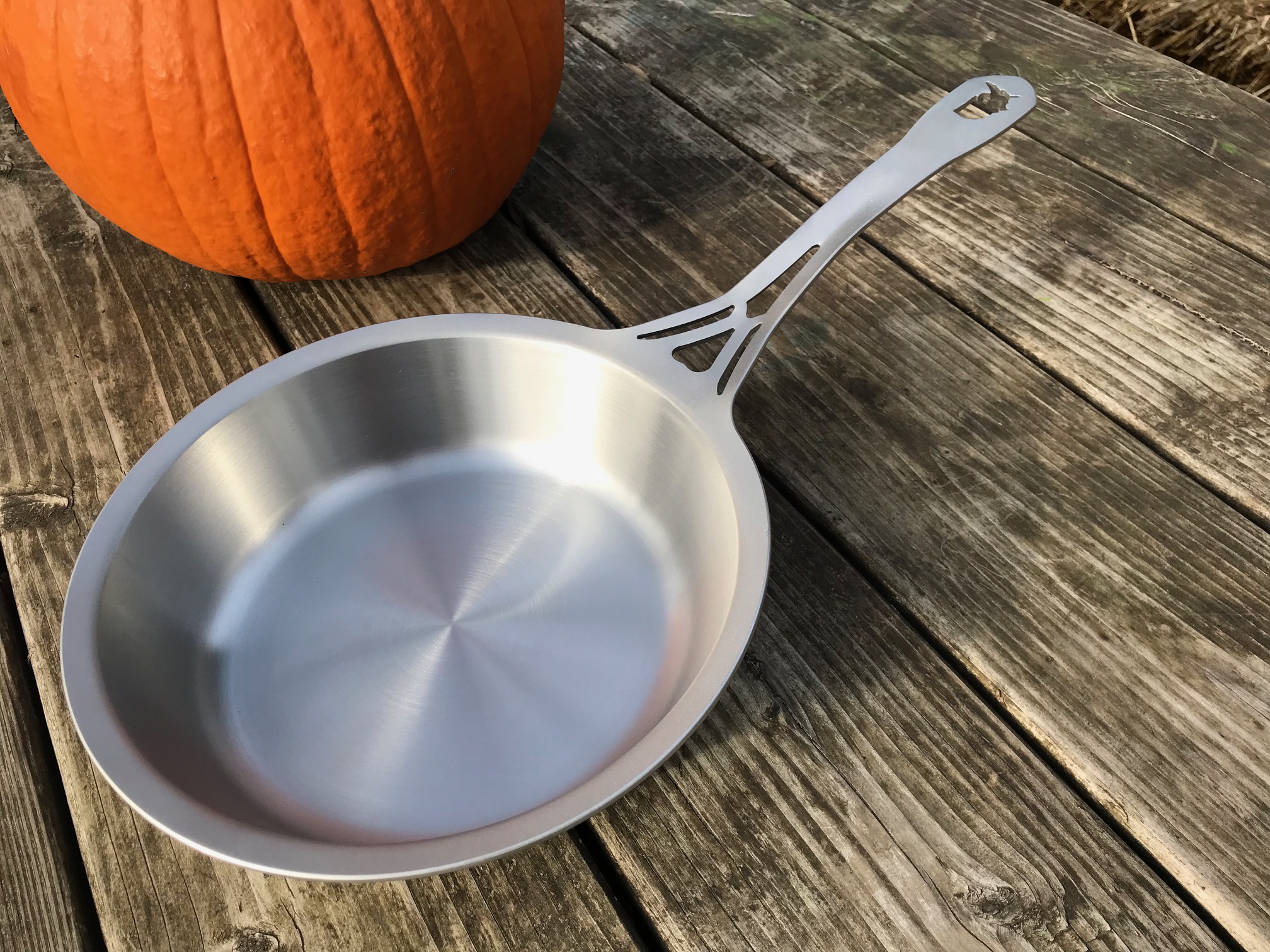
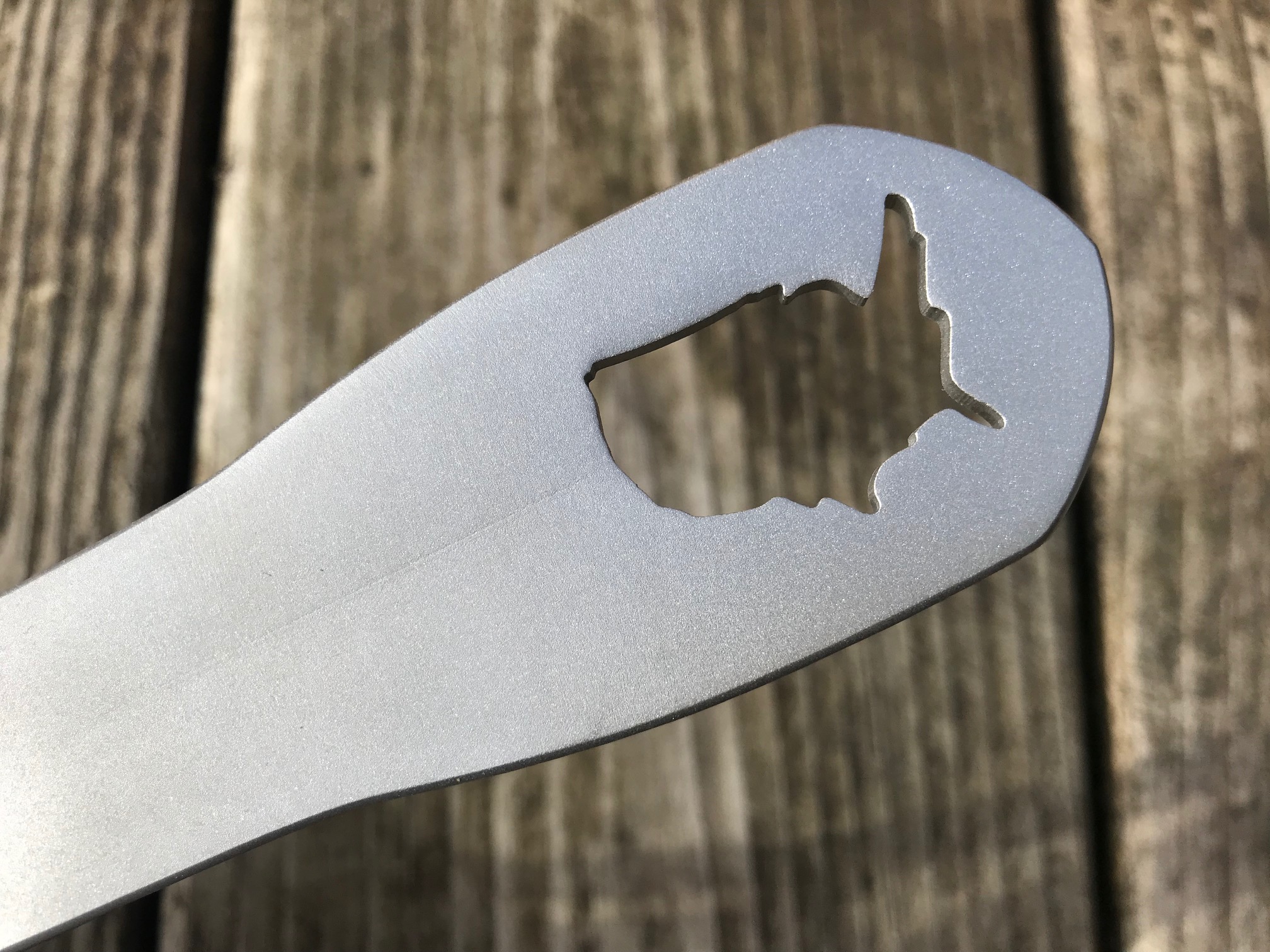
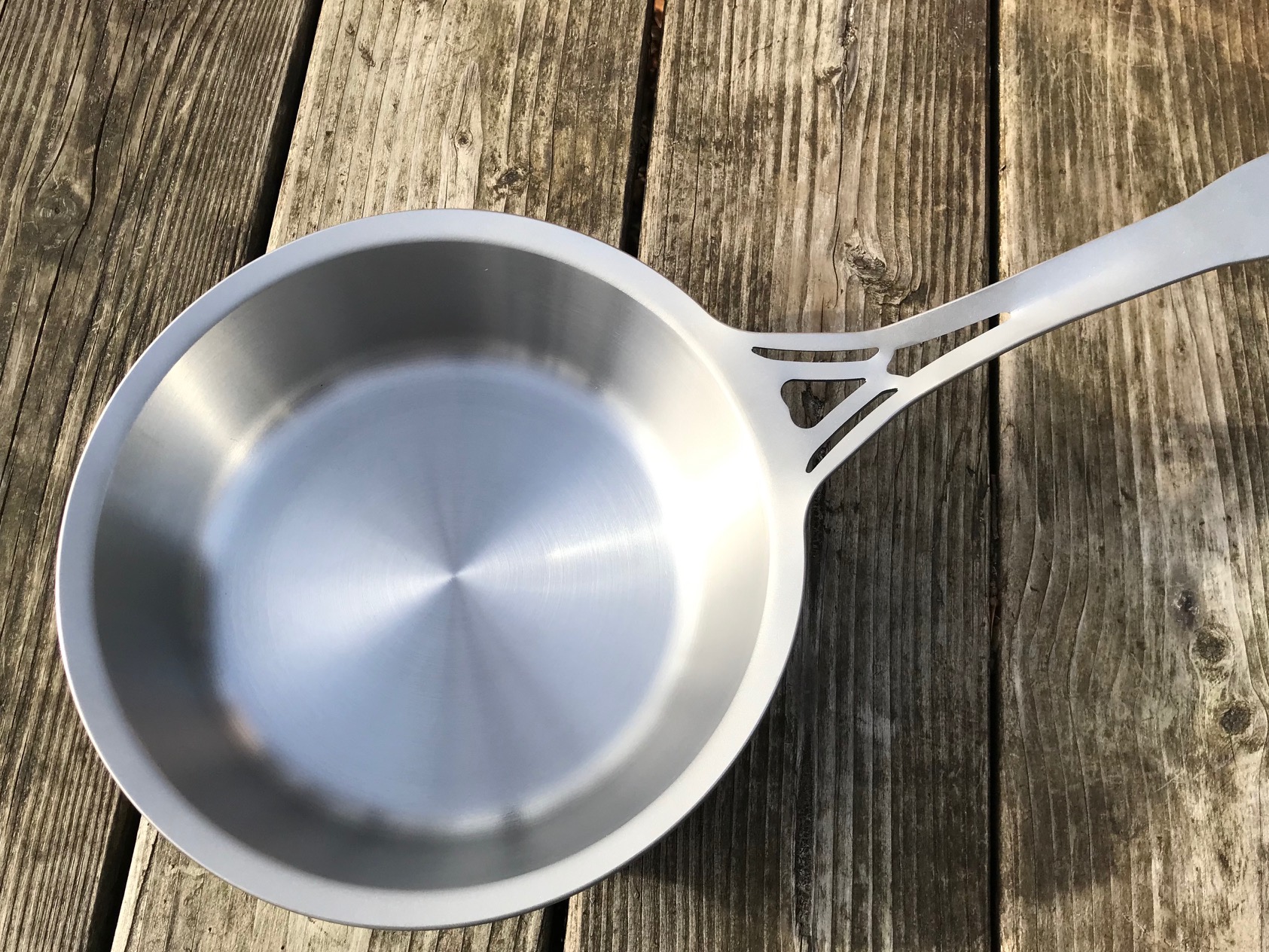
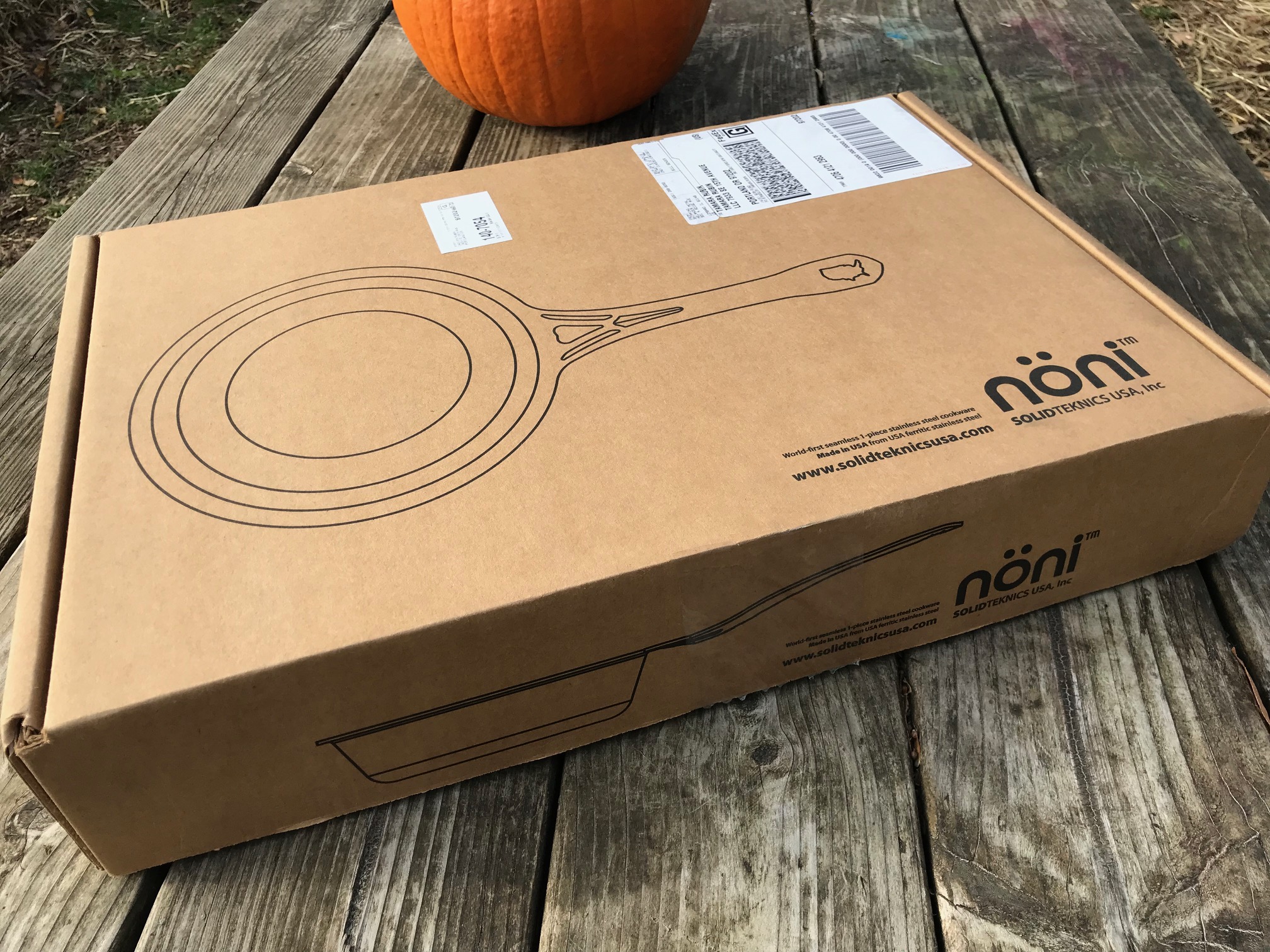
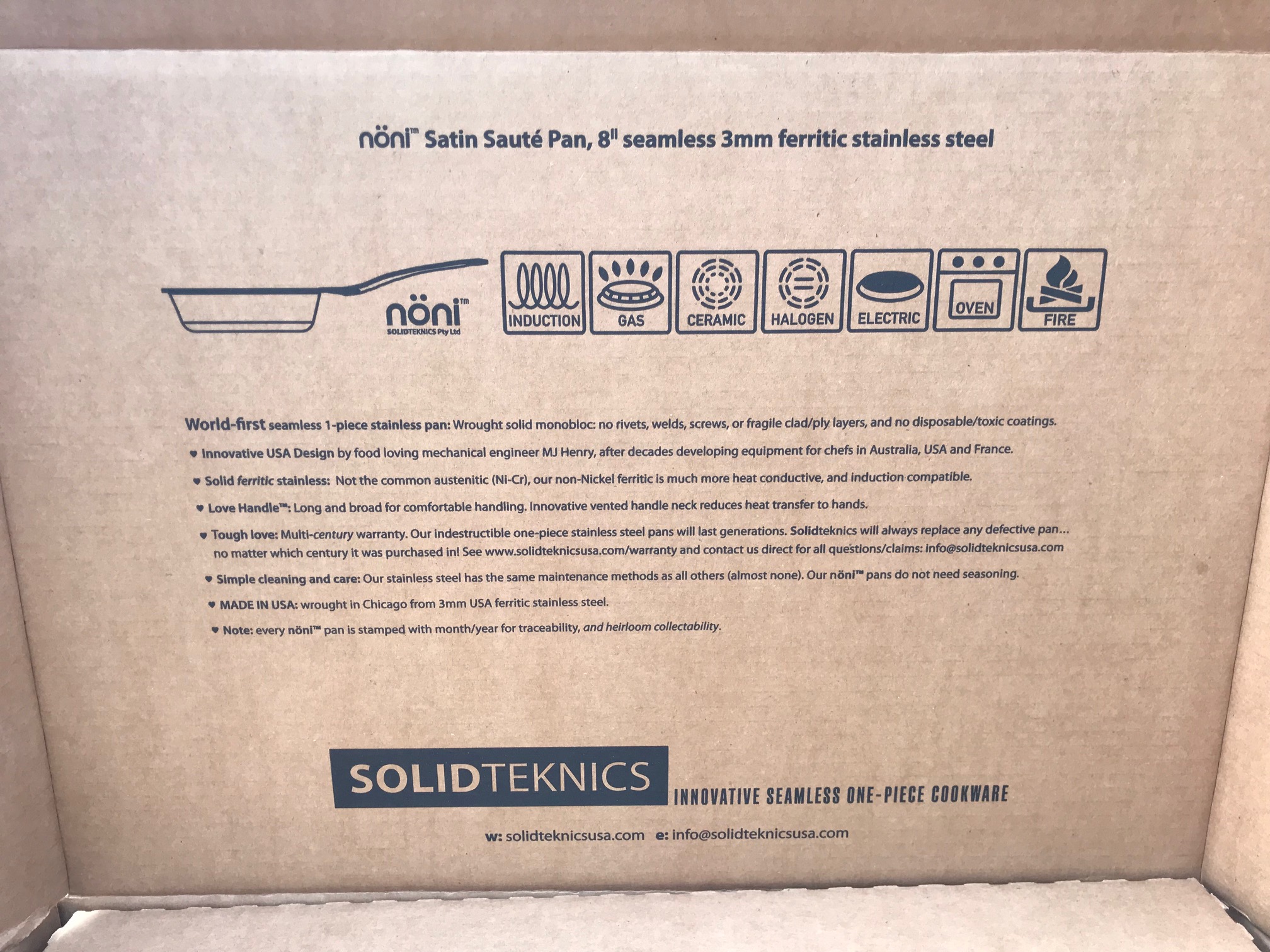
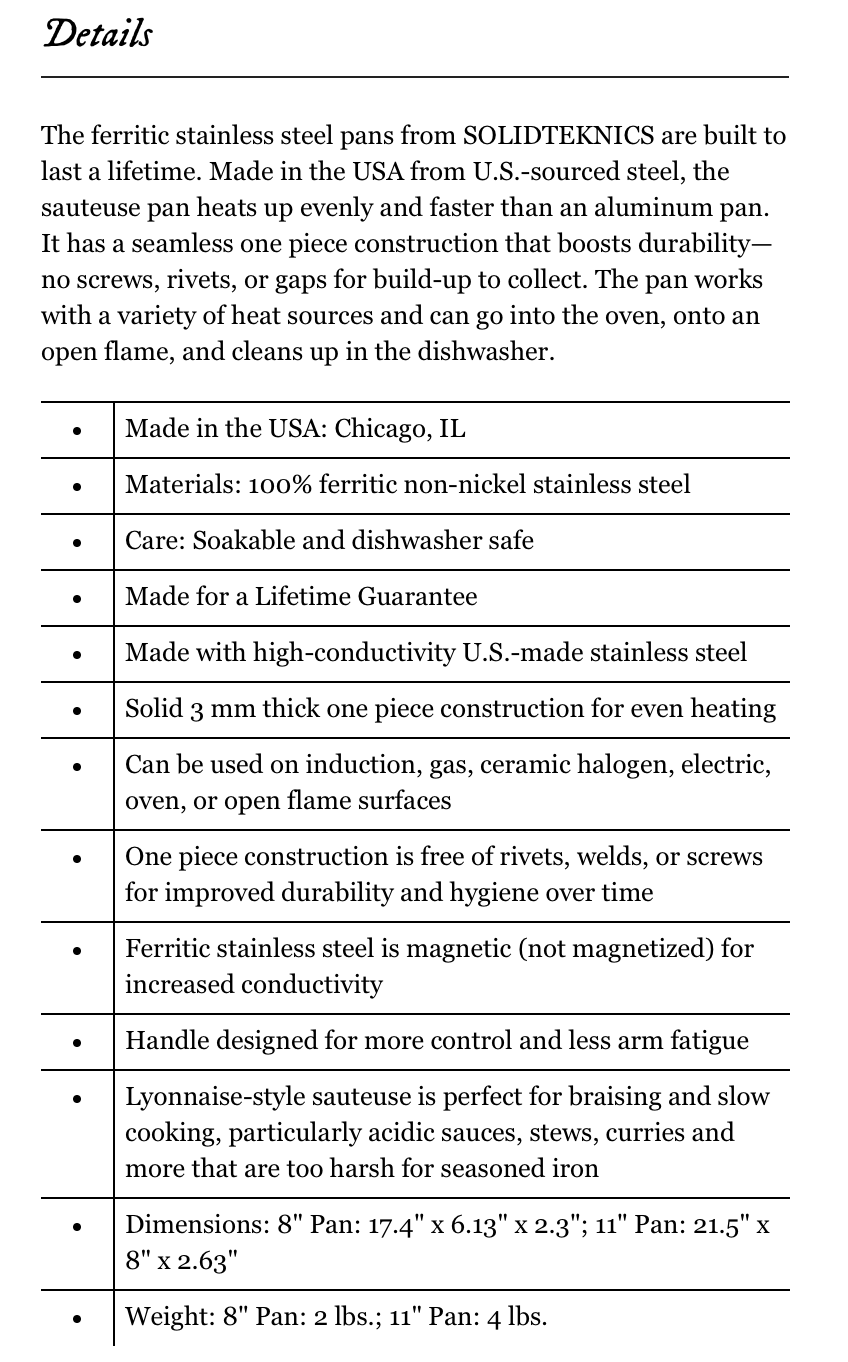
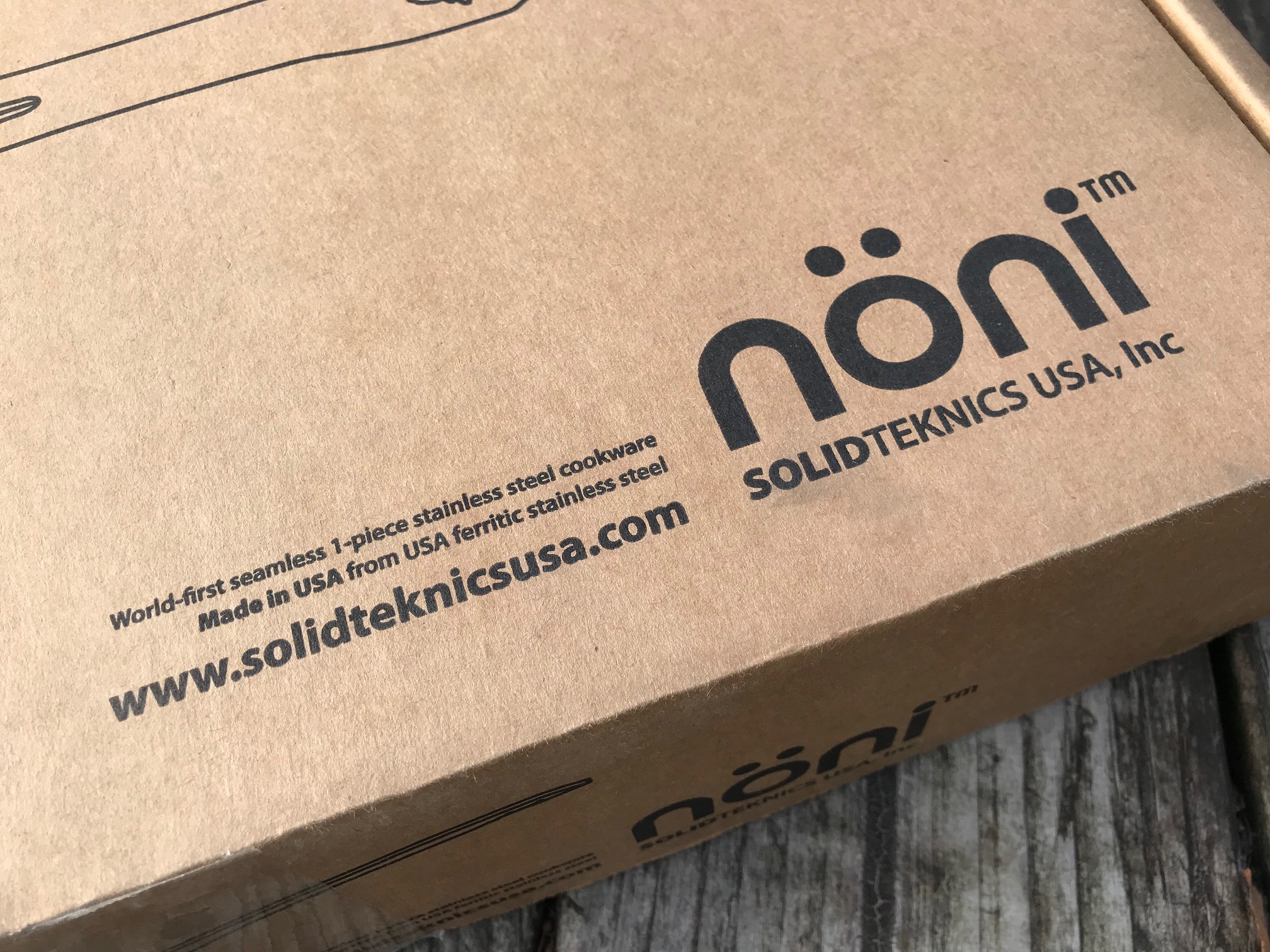
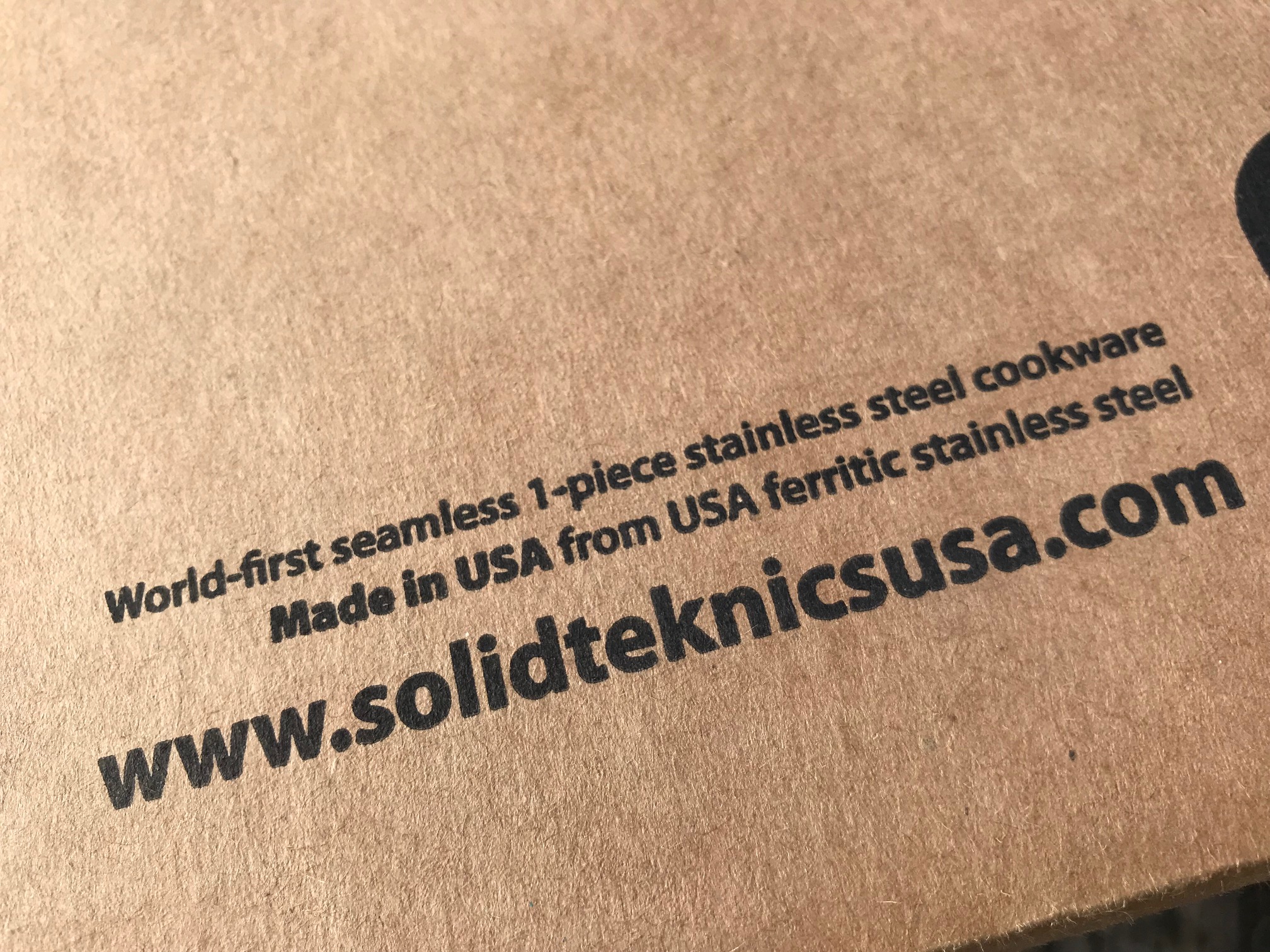
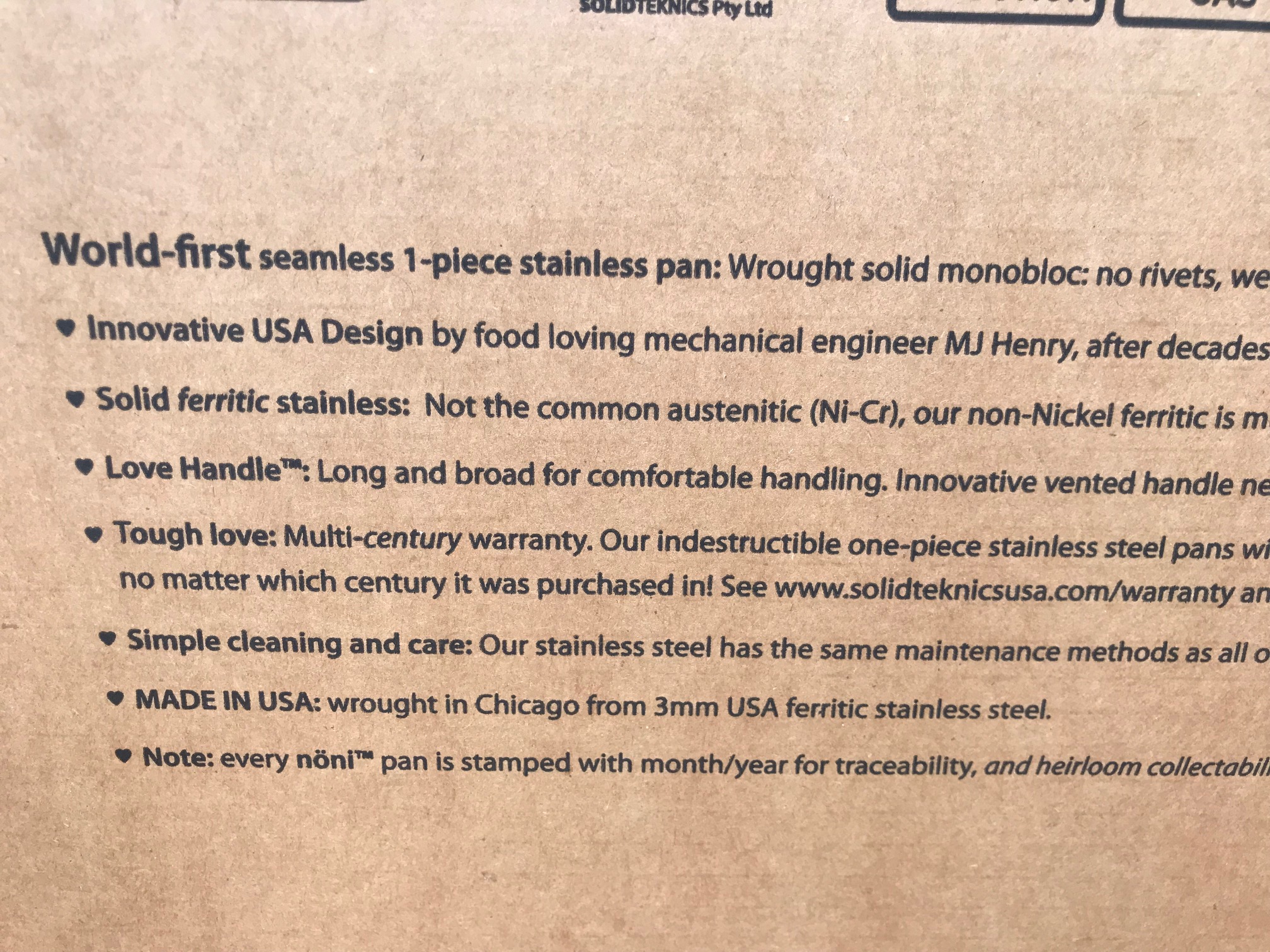
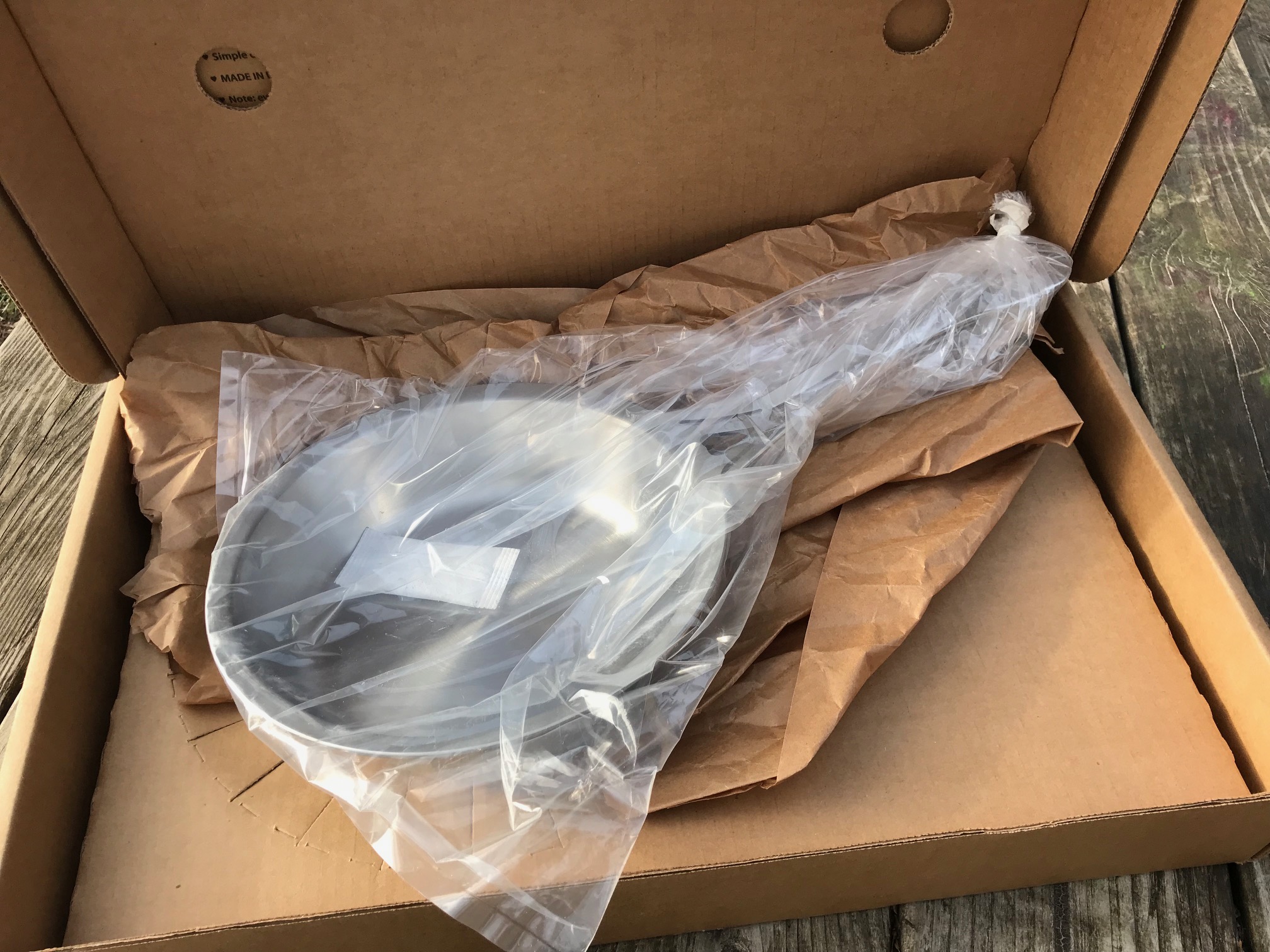
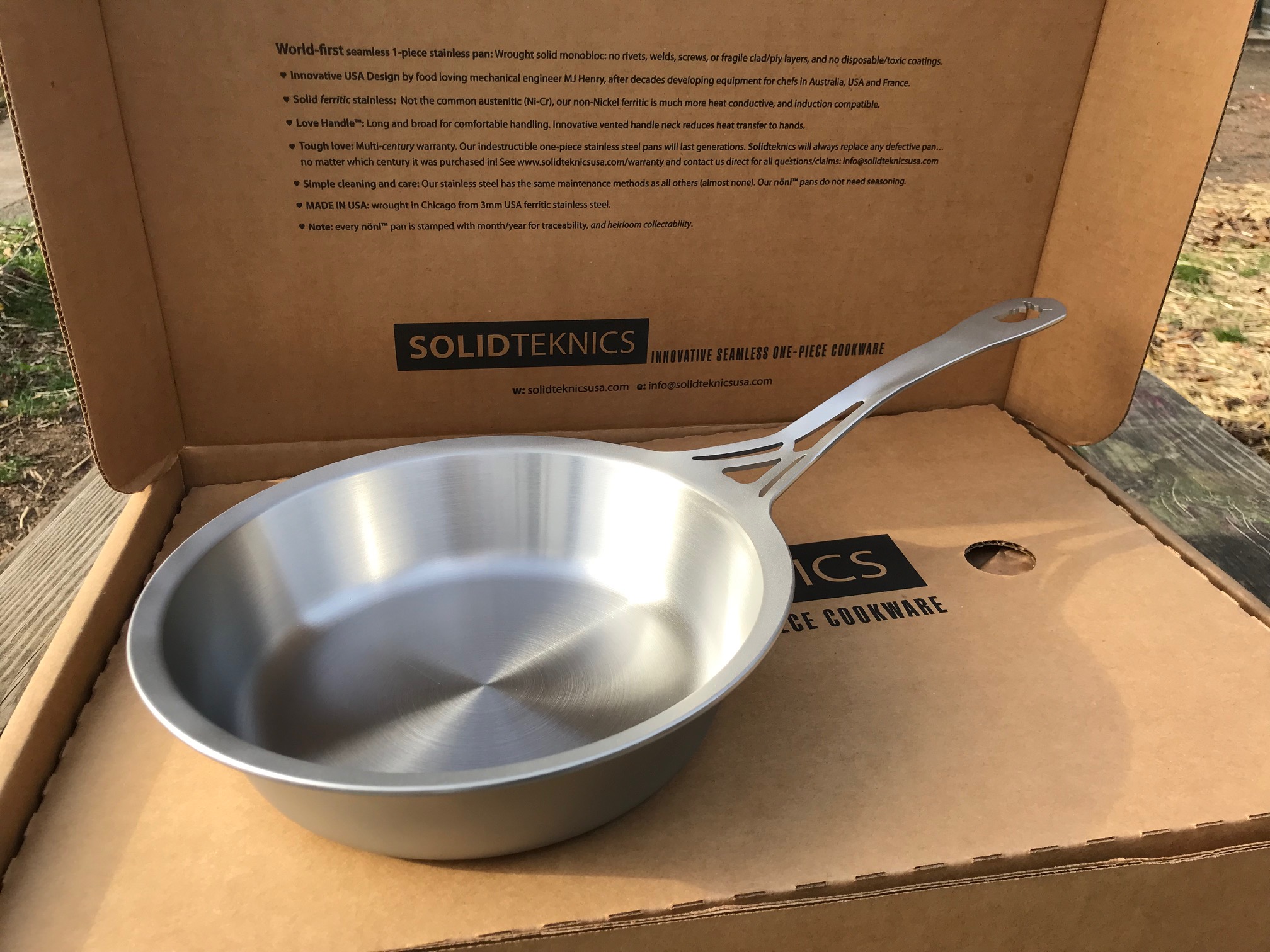
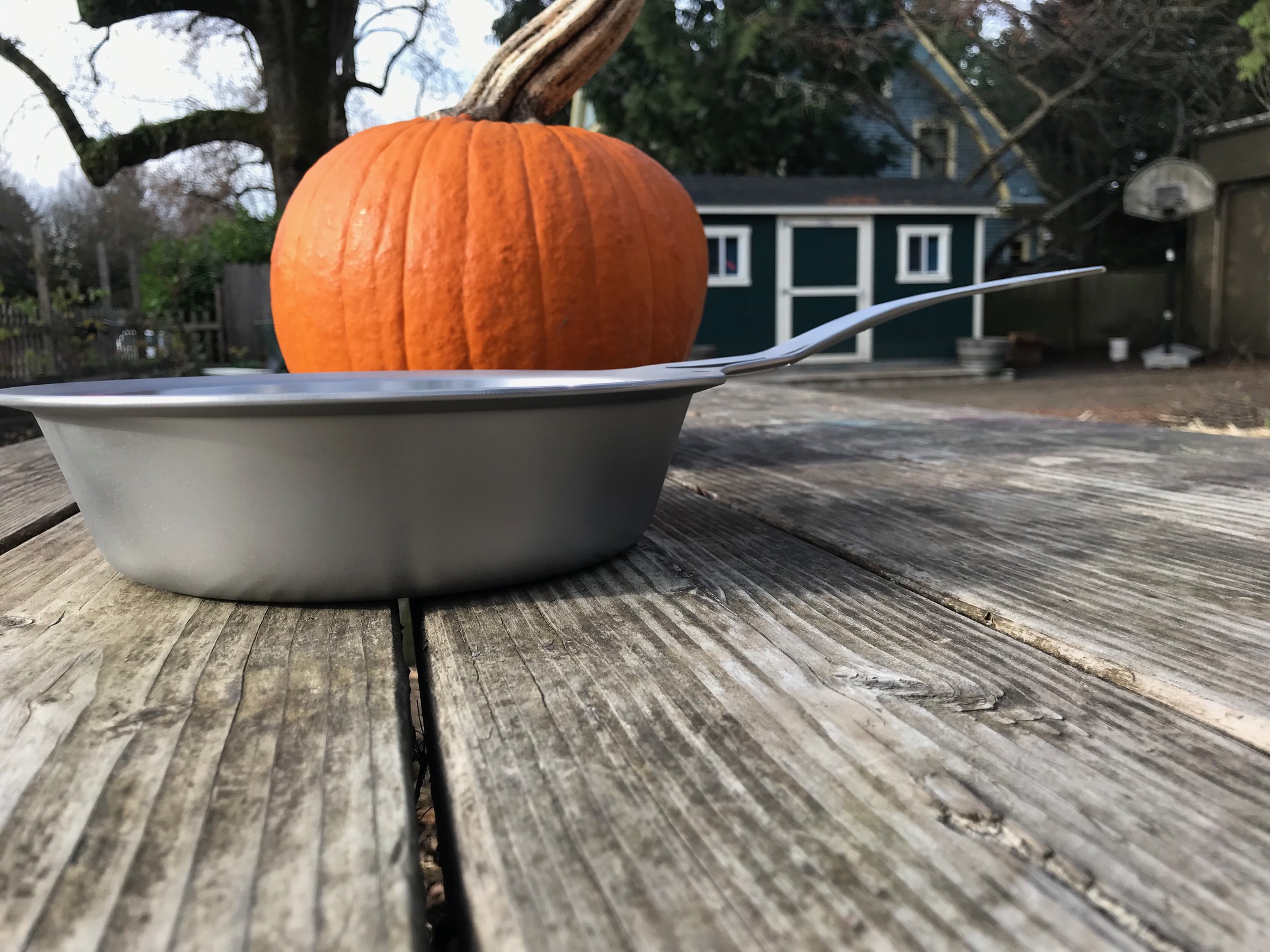
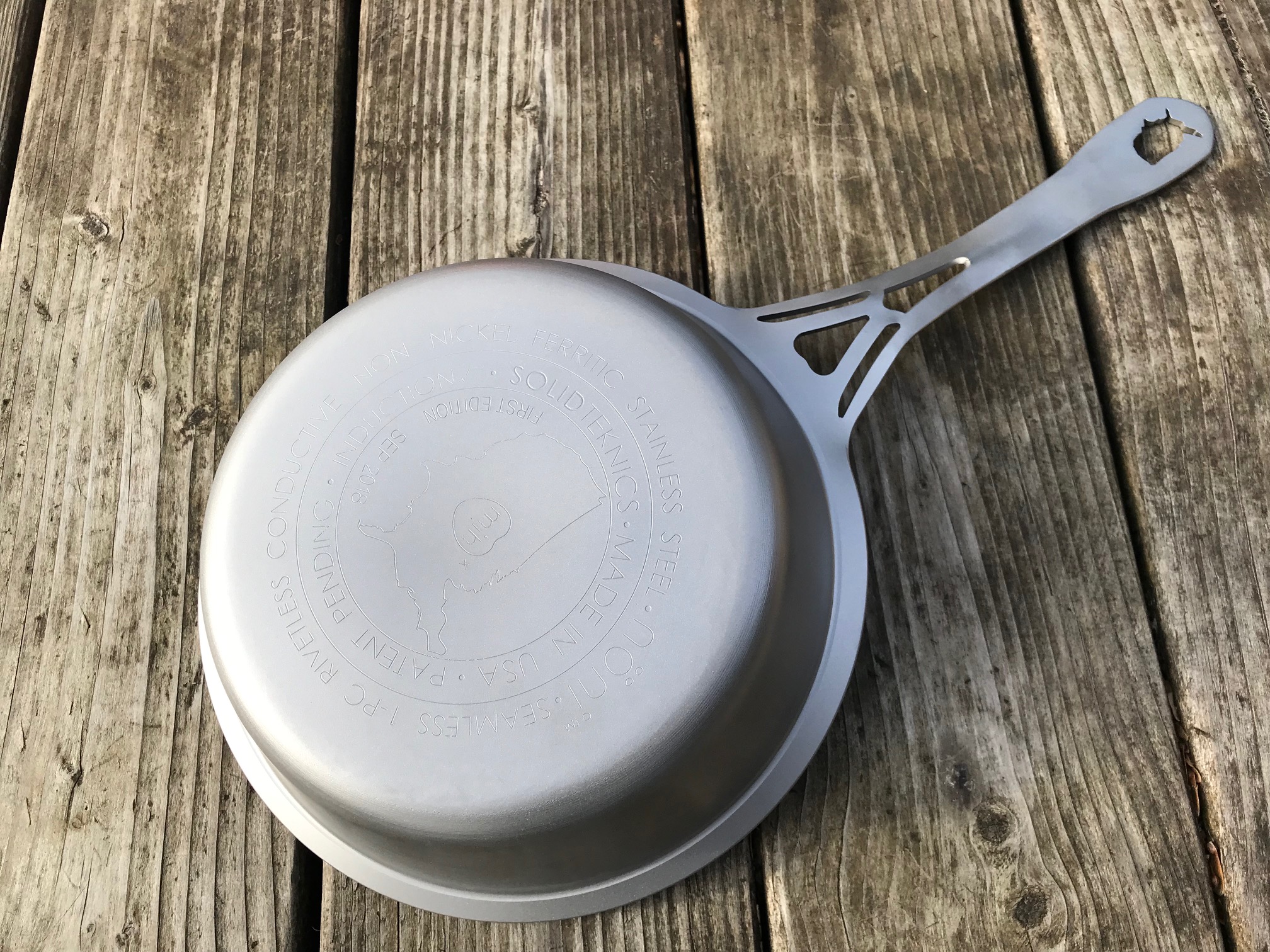
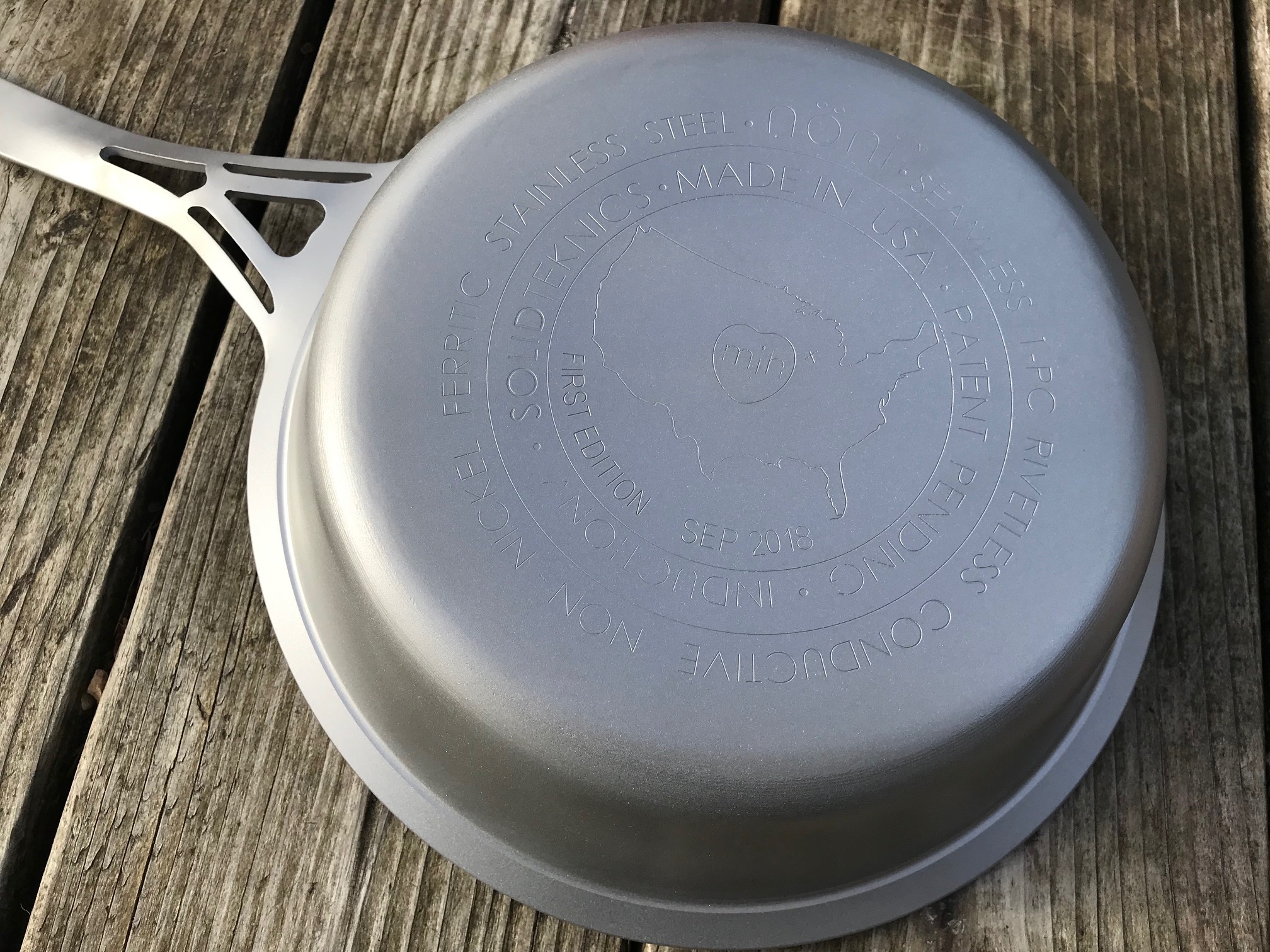
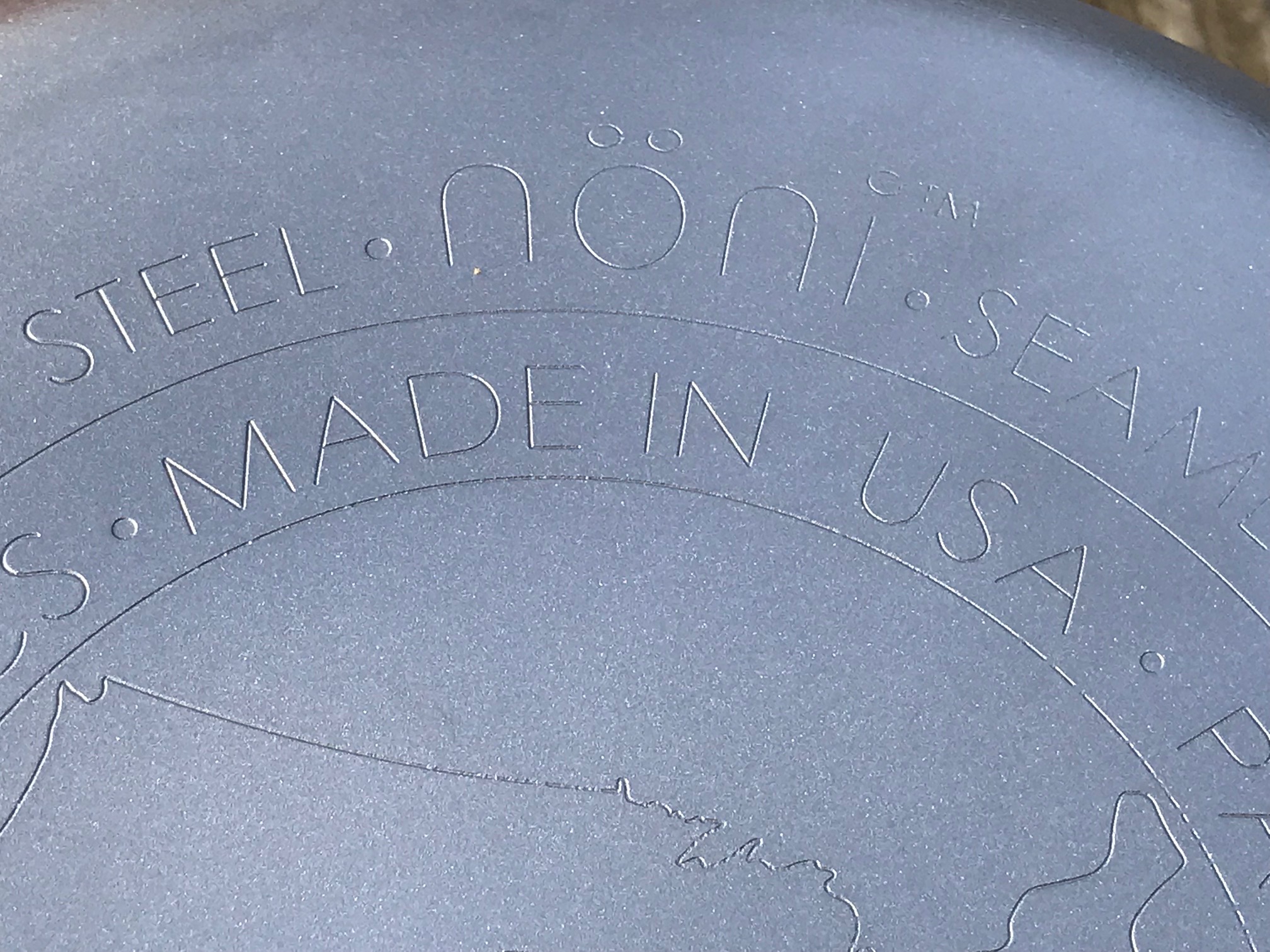
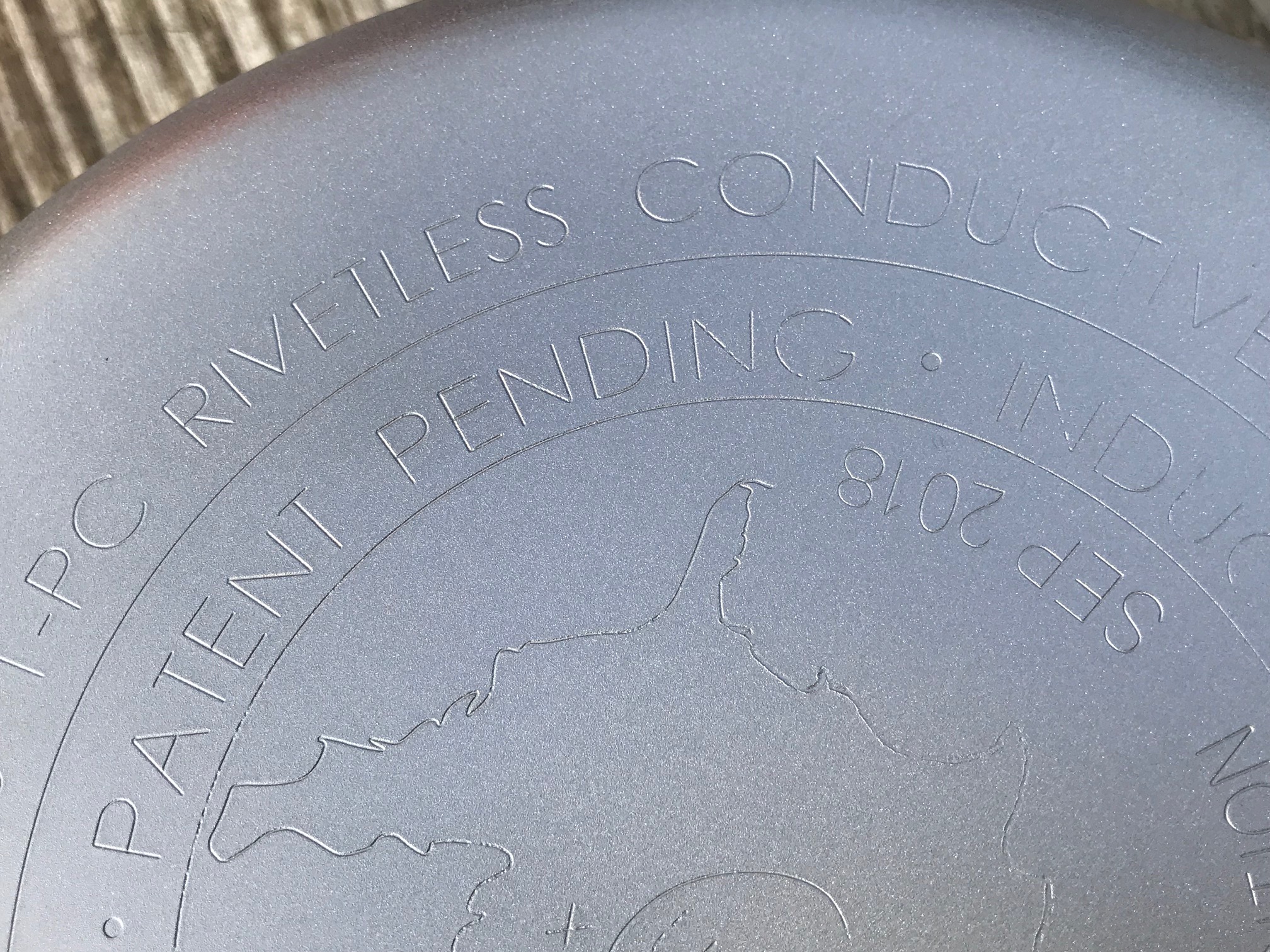
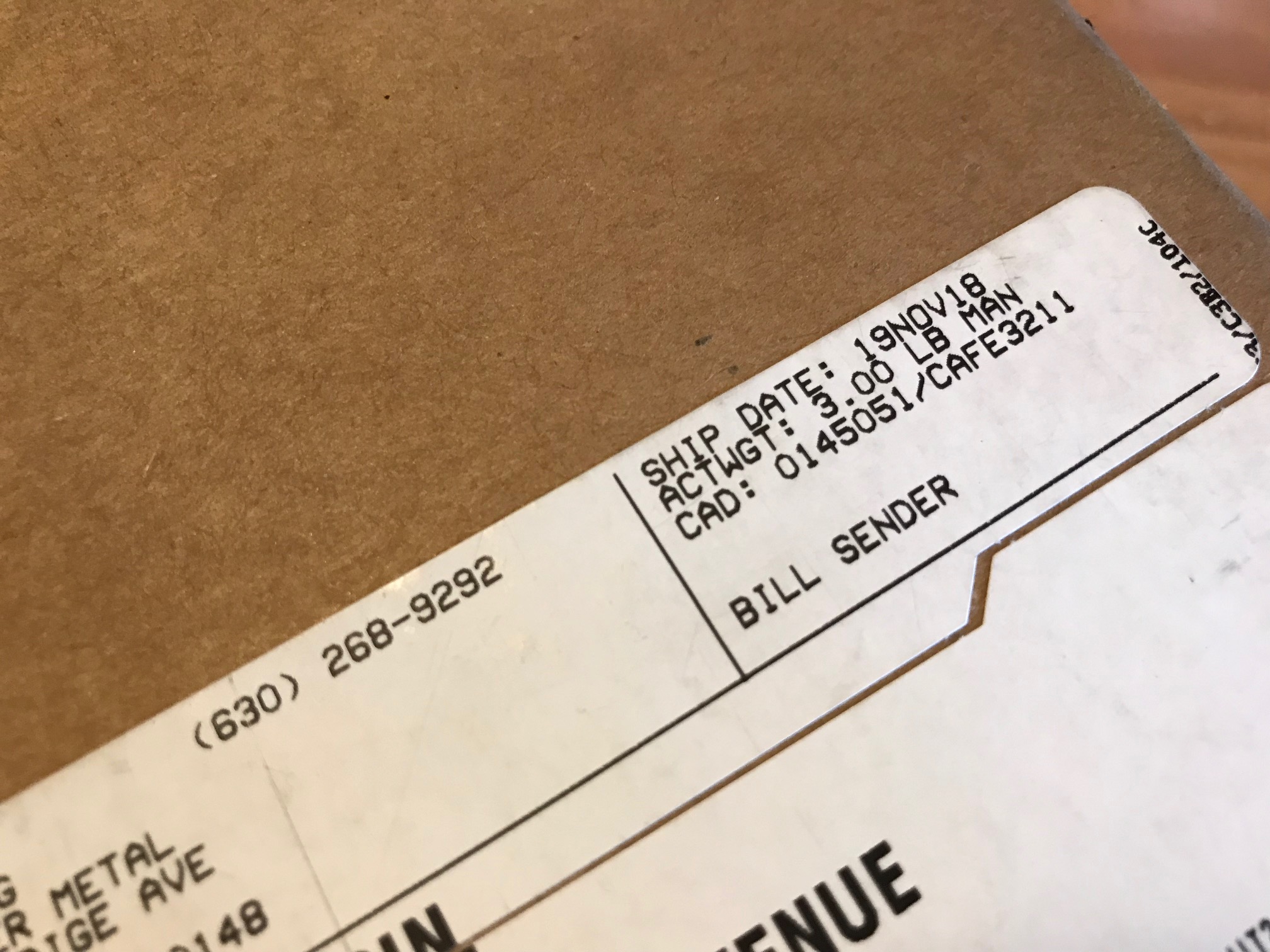

Hi Tamara!
Nice article! Now I have pan envy.
Unfortunately the cost of this pan is out of reach for many people.
I always try to cook with stainless steel pans.
Most stainless steel pans many brands have the rivets attachments (I guess that is what you mean by grommets?). So do kitchen knives/ steak knives etc- most have rivets. In fact rivets are ubiquitous to almost all sort of cookware.
Most people can’t afford XRF testing for all pans and pots they buy.
Many of us don’t live where there is ikea- I know you recently tested a pot from ikea with no lead in the rivets.
Are you suggesting that we shouldn’t buy anything that is riveted/ welded due to possible lead content in the rivets (as far as I am aware rivets used in cookware generally are aluminum alloy or stainless steel- so I wonder where the lead would come from).
Could you post examples of lead in the rivets/ joints you tested? Or give an idea of how much lead?
This is concerning as there is a 100% possibility that food will be cooked on contact the rivets in pans and pots.
If not then the statement can be quite alarmist and anxiety provoking for I guess everyone who owns any cookware or utensils really.
ThAnk you,
Cheryl
Hi Cheryl,
In my work I try to give people information so they can make informed decisions for their homes. I test things people send me to test. Someone sent me this pan to test. I would never buy something like this myself. I don’t even have money for groceries most days, let alone expensive cookware. However if you look through my posts you will see lots of examples of inexpensive lead-free options. My Lead Safe Mama Amazon Store also has a lot of inexpensive options for people. In general I recommend using a mix of Stainless Steel, Cast Iron, Clear Glass and Bamboo. I’m not ever trying to be alarmist – just to provide very specific information within a specific range (presence of Lead, Cadmium, Arsenic and Mercury.) I don’t really have a problem with Nickel in Stainless, but some people do – so this pan solves that problem to some degree, but so do the Ikea ones and Ikea ones cost $10 or $20 each and are low-Nickel and Lead-free. Ikea does mail order too – so you don’t need to live near one. The rivets that are often leaded are the pot-metal ones (usually aluminum based) that look dull gray (and they don’t touch the inside of the pot / food surface). I don’t ever recall testing knife rivets that were positive for Lead (although some of the yellow ones are positive for Mercury and Arsenic – but not Lead.)
T
You’re awesome. Sent this to someone who eats cooked food. Yep, this is why I’ve stayed raw for 8 years.
I just will check your stuff on glass jars, since that’s what I use for food storage.
Thank you for commenting!
– Tamara
Tamara, can you discuss the pros and cons of aluminum in pots and pans ? I need an Asian wok and they all seem to have an aluminum base.
https://www.amazon.com/Cuisinart-726-38H-Classic-Stainless-Stir-Fry/dp/B000ND3GQY
Hello,
Have you by chance tested the same companies “wrought iron” pans? I am really interested in those as well but not sure if they are non-toxic. Thank you!!
Leeandra
Hi Tamara. Have you ever tested Silit cookware from Germany? They have ceramic coated cast iron pots and pans.
Thanks, Loree
Hi Loree, not that I recall – sorry.
Tamara
Hi, Tamara. Thank you for all you do!
Have you tested the stainless steel (NOT the non-stick) All-Clad pots and pans (https://www.williams-sonoma.com/products/all-clad-d5-stainless-steel-10-piece-cookware-set/?catalogId=58&sku=1577881&cm_ven=PLA&cm_cat=Google&cm_pla=Cookware%20%3E%20Cookware%20Sets&cm_ite=1577881&gclid=Cj0KCQjwrpLoBRD_ARIsAJd0BIVaqfEENXYaKwt8GoXZkGpV-PmmyPs_fmfmTTkNbXx427LkumpRISEaAsevEALw_wcB). We have a set of these, and, along with our Lodge cast iron and Le Creuset pan, are what we use when cooking.
Thank you!
Do you recommend Cuisinart MCP-12N Multiclad Pro Stainless Steel 12-Piece Cookware over a nickel free set such as homichef?
Also, what about the Cuisinox stainless steel brand?
What is the solution for bathroom tiling? I saw in northern europe they use vinyl but i slipped and fell and had major accident. I live in Asia and we don’t have space for bath tubs in all bath rooms and wet bathrooms are common. In olden days Inthink they just left it cement rendered, is that a better option or you have other suggestion. And by the way, how about red oxide painting and terracota tile?
Hi Tamara!
Have you tested any of the SolidTeknic Iron pans? They are supposed to be alternative to cast iron.
Thank you 🙂
Rachael
Please please please recommend a safe slow cooker or large stock pot. I am desperate
Thanks!!
Dear Tamara, what is your opinion about MEYER select nickel free japanese stainless steel cookware.?
Have you tested pots n pans cookware set-3 ply stainless steel KitchenAid set?
Here’s my guidelines on pots and pans (as they apply to all brands):
https://tamararubin.com/2021/01/i-want-to-buy-some-nontoxic-cookware-which-pots-pans-are-the-safest-for-cooking-which-pots-pans-are-the-least-toxic/
Tamara
Great advice! Im headed over to the Ikea website, which is where I was going to buy my pot anyway!
Tamara: What do you recommend for an occasional use nonstick pan? We can’t use cast iron, which is somewhat nonstick naturally, as one family member hangs into iron. Thank you, Susan
I will have to give that some thought
Hello,
This is all pretty amazing . If I were to purchase pots from Ikea do you know which “model” you tested? 365+?
Thank you!
Did you already read the related post for the Ikea pot? If not, put “ikea” in the search bar and it should come up in the results. I don’t know what the model was -but you could share the post with a salesperson there and ask them.
Tamara
Does the copper ppm warrant any concern?
Have you tested any of the SolidTeknics Noni pans made in Australia? The are supposed to be made from German stainless steel. I wonder if the blend would be the same or if it would be a slightly different blend of metals.
I haven’t tested the ones directly from Australia – no.
T
Does the high level of Chromium raise any concerns?
Hi Bianca, if you haven’t yet read this – please do. It’s my overview post about the concerns for Stainless Steel.
https://tamararubin.com/2022/08/why-do-some-stainless-steel-cookware-items-have-a-prop-65-warning-isnt-stainless-steel-non-toxic/
T
Hi Tamara, I thought you did test the solidteknics brand from australia because those are the pots that are pictured on your website as recommended cookware…can you please clarify?
I tested each of the exact pans pictured in the posts with the test results.
Hi Tamara, Thank you for testing these products. Have you had a chance to test their Iron products as well?
https://solidteknicsusa.com/shop/10inchquenchedlightning
yes – click the “soliteknics” keyword at the top of this article and you will find those test results.
Hello, I’m debating whether to buy the Solidteknics flat skillet or the stargazer 13.5 inch braiser. Is there one you’d recommend over the other if you could afford it?
What about RevereWare?
Hi Tamara, Thank YOU for your informative site!
1) I have seen a few of your XRF results and notice they do not comment on aluminum. It doesn’t say not detect or a value. Does XRF test aluminum?
2) On your pots and pans page you have two Amazon links for glass stove pots. Multiple reviews state both these break easily. Do you have these pots and have they broken for you? I prefer a glass stove pot, but these seem to be non-existent minus the 2 you listed (baking I can find/stove no luck). Any changes on this by chance?
Sincere appreciation!
Hello and thank you, Tamara, for everything you already have done and continue to do to try to improve the chances of wellness for newborns and developing children in our global community (and for young people and adults!).
So many of us are making grateful, sharp u-turn changes in our consumption habits based on yours and others’ scientifically reproduceable third party testing — so life-preservingly gathered here by you.
My hope and prayer is that you might receive for XRF testing from one or more supporters either an example of
1) a Solidteknics’ German sourced 3mm stainless steel pot (Australian made NoNi) and/or
2) one of the newer Finnish sourced Solidteknics 2mm (Lightning) stainless steel (Australian made NoNi) pans on a current Kickstarter (2023-24).
Were you to receive such gifts, what a blessing your own eventual XRF results about these items (posted alongside your results for the US Solidteknics skillet above) would be to so many of your supporters who have already taken the leap into Soliteknics pots and pans but were not able to obtain a USA Solidteknics Noni Stainless steel product due to living outside of the US.
The same would go for those of us who have only had access to Australian sourced Aus-Ion Solidteknics pots and pans (wrought iron) rather than to the US sourced wrought iron Solidteknic Ion pans you XRF’d in your example for the link above.
Perhaps the results are likely to be comparable or identical?
Or perhaps Solidteknics has already commissioned (or could commission) XRFing of this nature from you, even if it is not batch testing but instead simply three pots to acknowledge the differing sources for metal sheeting (German, Finnish, and Australian) for Australian vs. US made Solidteknics pots.
Many in Europe, the UK, as well as Australia and South East Asia are buying Solidteknics products but none of us have the US Solidteknics pans.
And since the US branch of the Australian company has paused production, it seems that it may only possible to purchase Solidteknics at the moment off kickstarter shipped from Australia or from stores around the globe who carry inventory in Australian-made Solidteknics but not the US Solidteknics products (i.e. products sourced either from German 3mm or Finnish 2mm stainless steel metal sheets or from Australian 3mm or 2.5mm iron metal sheets).
Finally, how can we thank you for your public minded posting of scientific results from third party testing for lead within a range of brands of chocolate, in various brands of salt, and among various seed oil types and brands?
Given how lead has stolen into a range of contemporary food and water chains, might Solidteknics’ Aus-Ion (wrought iron) range of pots and pans offer some small protection by blocking some amount of the uptake of lead from food sources? (I recall reading one or two scientific studies about this more than 15 years ago, but do not have the citations. Do you, I wonder? )
Giving thanks!
Laura
Hi Tamara!
I am following your amazing guidelines but I still have a question.
Most cookware isn’t 100% stainless steel surgical grade but rather that and bonded to either aluminum at the core or copper. Are these metals capable of leaching?
Mainly I’m concerned that the aluminum could leach into the stainless steel layer and therefore cook into my food.
I prefer to buy made in USA products.
I have one All Clad fry pan and the rest is Royal Prestige. All Clad has stainless steel and then aluminum followed by copper another layer of aluminum and then the bottom like the cooking surface is stainless steel.
Royal Prestige cookware is constructed with five layers of metals – three layers of aluminium sandwiched between two layers of stainless steel.
Also I saw you no longer recommend All Clad can you explain why.
Thanks so much for your time on this. Super appreciated!!
Warmly,
Brooke
Hello,
I have been wanting to purchase some of the SolidTeknics noni stainless steel skillets but the provided links to the website does not have the noni. Is there a way for consumers in the U.S.A. to make purchases without ordering from the Austrailian website? Thank you…
Hi! I don’t see any mention of Aluminum. Have you done any aluminum testing for this pan? If not, I would really appreciate seeing that, and was surprised it’s not covered here since it’s an issue with other pans like you’ve mentioned with GreenPan etc.